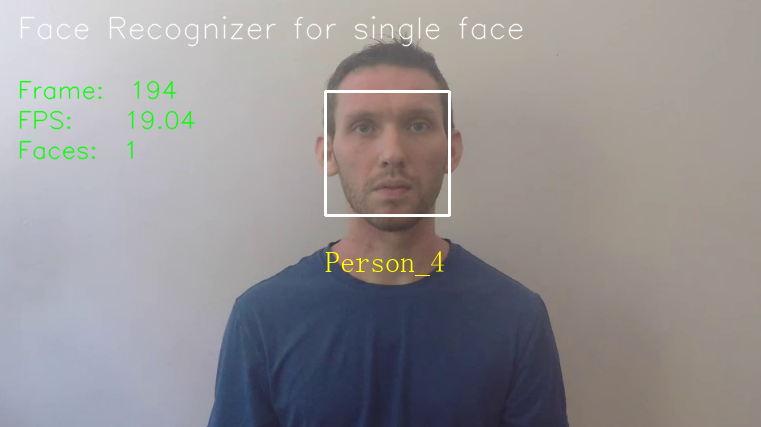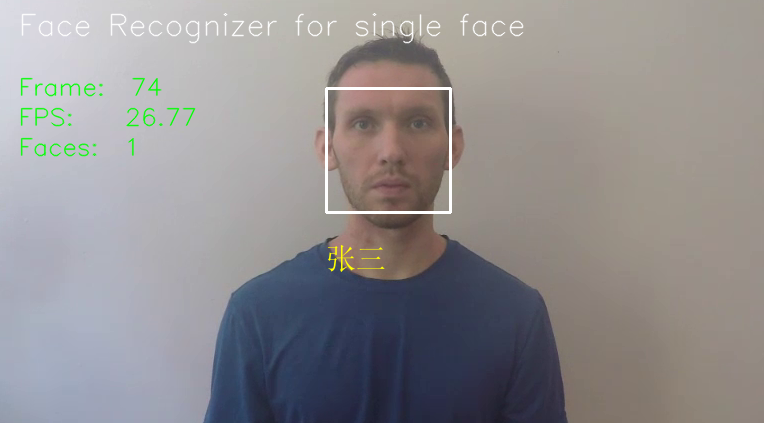调用摄像头进行人脸识别, 支持多张人脸同时识别 / Detect and recognize single or multi faces from camera;
Tkinter 人脸录入界面, 支持录入时设置 (中文) 姓名 / Face register GUI with Tkinter, support setting (chinese) name when registering

简单的 OpenCV 摄像头人脸录入界面 / Simple face register GUI with OpenCV, tkinter not needed and cannot set name

离摄像头过近, 人脸超出摄像头范围时, 会有 "OUT OF RANGE" 提醒 / Too close to the camera, or face ROI out of camera area, will have "OUT OF RANGE" warning;

提取特征建立人脸数据库 / Generate face database from images captured
利用摄像头进行人脸识别 / Face recognizer
face_reco_from_camera.py, 对于每一帧都做检测识别 / Do detection and recognition for every frame:

face_reco_from_camera_single_face.py, 对于人脸<=1, 只有新人脸出现才进行再识别来提高 FPS / Do re-reco only for new single face:

face_reco_from_camera_ot.py, 利用 OT 来实现再识别提高 FPS / Use OT to instead of re-reco for every frame to improve FPS:

定制显示名字, 可以写中文 / Show chinese name:

** 关于精度 / About accuracy:
- When using a distance threshold of
0.6, the dlib model obtains an accuracy of99.38%on the standard LFW face recognition benchmark.
** 关于算法 / About algorithm
- 基于 Residual Neural Network / 残差网络的 CNN 模型;
- This model is a ResNet network with 29 conv layers.
It's essentially a version of the ResNet-34 network from the paper Deep Residual Learning for Image Recognition by He, Zhang, Ren, and Sun with a few layers removed and the number of filters per layer reduced by half.
此项目中人脸识别的实现流程 (no OT, 每一帧都进行检测+识别) / Design of this repo, do detection and recognization for every frame:
实现流程 (with OT, 初始帧进行检测+识别, 后续帧检测+质心跟踪) / OT used:
如果利用 OT 来跟踪, 可以大大提高 FPS, 因为做识别时候需要提取特征描述子的耗时很多 / Use OT can save the time for face descriptor computation to improve FPS;
下载源码 / Git clone source code
git clone https://github.com/coneypo/Dlib_face_recognition_from_camera
安装依赖库 / Install some python packages needed
pip install -r requirements.txt
进行人脸信息采集录入, Tkinter GUI / Register faces with Tkinter GUI
# Install Tkinter sudo apt-get install python3-tk python3-pil python3-pil.imagetk python3 get_faces_from_camera_tkinter.py进行人脸信息采集录入, OpenCV GUI / Register faces with OpenCV GUI, same with above step
python3 get_face_from_camera.py
提取所有录入人脸数据存入
features_all.csv/ Features extraction and save intofeatures_all.csvpython3 features_extraction_to_csv.py
调用摄像头进行实时人脸识别 / Real-time face recognition
python3 face_reco_from_camera.py
对于人脸数<=1, 调用摄像头进行实时人脸识别 / Real-time face recognition (Better FPS compared with
face_reco_from_camera.py)python3 face_reco_from_camera_single_face.py
利用 OT 算法, 调用摄像头进行实时人脸识别 / Real-time face recognition with OT (Better FPS)
python3 face_reco_from_camera_ot.py
代码结构 / Code structure:
. ├── get_faces_from_camera.py # Step 1. Face register GUI with OpenCV ├── get_faces_from_camera_tkinter.py # Step 1. Face register GUI with Tkinter ├── features_extraction_to_csv.py # Step 2. Feature extraction ├── face_reco_from_camera.py # Step 3. Face recognizer ├── face_reco_from_camera_single_face.py # Step 3. Face recognizer for single person ├── face_reco_from_camera_ot.py # Step 3. Face recognizer with OT ├── face_descriptor_from_camera.py # Face descriptor computation ├── how_to_use_camera.py # Use the default camera by opencv ├── data │ ├── data_dlib # Dlib's model │ │ ├── dlib_face_recognition_resnet_model_v1.dat │ │ └── shape_predictor_68_face_landmarks.dat │ ├── data_faces_from_camera # Face images captured from camera (will generate after step 1) │ │ ├── person_1 │ │ │ ├── img_face_1.jpg │ │ │ └── img_face_2.jpg │ │ └── person_2 │ │ └── img_face_1.jpg │ │ └── img_face_2.jpg │ └── features_all.csv # CSV to save all the features of known faces (will generate after step 2) ├── README.rst └── requirements.txt # Some python packages needed
用到的 Dlib 相关模型函数 / Dlib related functions used in this repo:
Dlib 正向人脸检测器 (based on HOG), output:
<class 'dlib.dlib.rectangles'>/ Dlib frontal face detectordetector = dlib.get_frontal_face_detector() faces = detector(img_gray, 0)
Dlib 人脸 landmark 特征点检测器, output:
<class 'dlib.dlib.full_object_detection'>/ Dlib face landmark predictor, will useshape_predictor_68_face_landmarks.dat# This is trained on the ibug 300-W dataset (https://ibug.doc.ic.ac.uk/resources/facial-point-annotations/) # Also note that this model file is designed for use with dlib's HOG face detector. # That is, it expects the bounding boxes from the face detector to be aligned a certain way, the way dlib's HOG face detector does it. # It won't work as well when used with a face detector that produces differently aligned boxes, # such as the CNN based mmod_human_face_detector.dat face detector. predictor = dlib.shape_predictor("data/data_dlib/shape_predictor_68_face_landmarks.dat") shape = predictor(img_rd, faces[i])
Dlib 特征描述子 / Face recognition model, the object maps human faces into 128D vectors
face_rec = dlib.face_recognition_model_v1("data/data_dlib/dlib_face_recognition_resnet_model_v1.dat")
Python 源码介绍如下 / Source code:
get_face_from_camera.py:人脸信息采集录入 / Face register with OpenCV GUI
- 请注意存储人脸图片时, 矩形框不要超出摄像头范围, 要不然无法保存到本地;
- 超出会有 "out of range" 的提醒;
get_faces_from_camera_tkinter.py:进行人脸信息采集录入 Tkinter GUI / Face register with Tkinter GUI
features_extraction_to_csv.py:从上一步存下来的图像文件中, 提取人脸数据存入 CSV / Extract features from face images saved in step 1;
- 会生成一个存储所有特征人脸数据的
features_all.csv - Size:
n*129, n means n faces you registered and 129 means face name + 128D features of this face
- 会生成一个存储所有特征人脸数据的
face_reco_from_camera.py:这一步将调用摄像头进行实时人脸识别; / This part will implement real-time face recognition;
- 将捕获到的人脸数据和之前存的人脸数据进行对比计算欧式距离, 由此判断是否是同一个人;
- Compare the faces captured from camera with the faces you have registered which are saved in
features_all.csv;
face_reco_from_camera_single_face.py:针对于人脸数 <=1 的场景, 区别于
face_reco_from_camera.py(对每一帧都进行检测+识别), 只有人脸出现的时候进行识别;face_reco_from_camera_ot.py:只会对初始帧做检测+识别, 对后续帧做检测+质心跟踪;
(optional)
face_descriptor_from_camera.py调用摄像头进行实时特征描述子计算; / Real-time face descriptor computation;
- 如果希望详细了解 dlib 的用法, 请参考 Dlib 官方 Python api 的网站 / You can refer to this link for more information of how to use dlib: http://dlib.net/python/index.html
- Modify log level to
logging.basicConfig(level=logging.DEBUG)to print info for every frame if needed (Default islogging.INFO) - 代码最好不要有中文路径 / No chinese characters in your code directory
- 人脸录入的时候先建文件夹再保存图片, 先
N再S/ PressNbeforeS - 关于
face_reco_from_camera.py人脸识别卡顿 FPS 低问题, 原因是特征描述子提取很费时间; 光跑face_descriptor_from_camera.py中face_reco_model.compute_face_descriptor在我的机器上得到的平均 FPS 在 5 左右 (检测在0.03s, 特征描述子提取在0.158s, 和已知人脸进行遍历对比在0.003s左右); 所以主要提取特征时候耗资源, 可以用 OT 去做追踪 (使用face_reco_from_camera_ot.py), 而不是对每一帧都做检测+识别, 识别的性能从 20 FPS -> 200 FPS
可以访问我的博客获取本项目的更详细介绍, 如有问题可以邮件联系我 / For more details, please visit my blog (in chinese) or send mail to coneypo@foxmail.com:
- Blog: https://www.cnblogs.com/AdaminXie/p/9010298.html
- 关于 OT 部分的更新在 Blog: https://www.cnblogs.com/AdaminXie/p/13566269.html
- Feel free to create issue or contribute PR for it:)
Thanks for your support.

